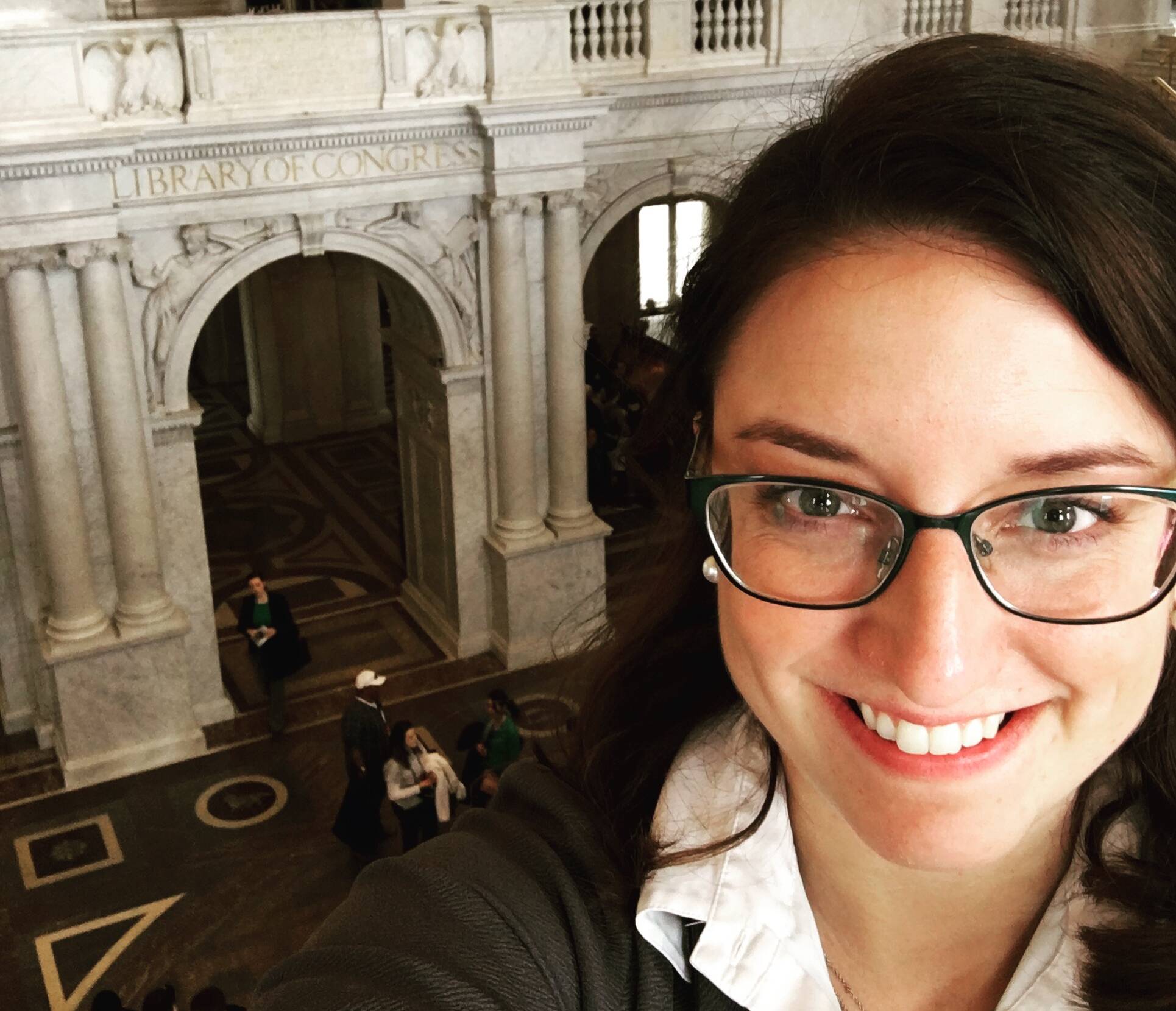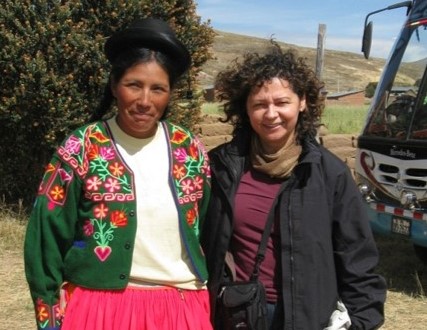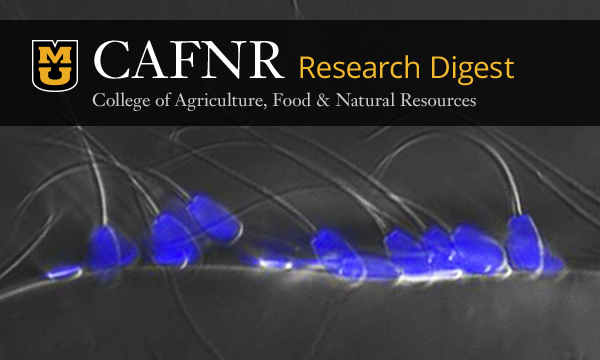|
CAFNR Office of Research Newsletter // Feb. 28, 2019 |
|
Agricultural Research Centers |
|
MU's Foremost Dairy at the Front of the Herd »
|
|
Holstein Association USA recently named the University of Missouri’s Foremost Dairy Research Center as one of the top 10 college/university herds. Foremost Dairy milks more than 200 cows twice a day. The Center, which is located just west of Columbia, is home to a mixture of Holstein and Guernsey cows. Faculty and students do research at the farm to learn how to improve milk output and efficiency while maintaining herd health. Genomic testing and research undertaken at Foremost pay off in better production and longevity, and total performance index (TPI) numbers rose from an average of 1800-1900 to 2000-2100 in the past five years. Operated by MU’s College of Agriculture, Food and Natural Resources, Foremost earned fame for Pastel, a Holstein heifer born there in 2014. With a TPI of 2561, Pastel was rated as the second-best red carrier Holstein calf in the country and was sold for $25,500. All calves’ genomes are tested now. Learn more about the dairy online. |
|
|
Graduate Student Spotlight |
|
Rachel Owen, School of Natural Resources |

|
What Is your research focus?
My research focuses on the response of Great Plains wetlands to changing climate conditions. Playa wetlands are remnant natural ecosystems that exist in an agriculturally dominated landscape. They provide important ecosystems services such as wildlife habitat, nutrient filtration, and they recharge the Ogallala aquifer. Playas and the organisms they support are accustomed to extreme weather; therefore, we may expect that they are fairly resilient to changing climate conditions. We tested the impacts of increased temperature, changing precipitation and changing land use patterns in controlled environments and have identified soil and plant processes that may be areas of management concern in the future. We also worked with local managers and landowners to assess their attitudes toward climate change and gain insight into how resource users will respond to future climate conditions. Why does this field interest you?
My background is in soil science. When I was an undergraduate student at Iowa State University, I became fascinated with soils because they exist throughout the world and they are incredibly important for food production and environmental sustainability. I knew that I wanted to pursue research in an area that could bridge disciplines and would have direct applications to people’s livelihoods. Today, I enjoy that I get to work at the interface of conservation and agriculture and work towards finding sustainable solutions for both sectors. Why did you decide to come to Mizzou?
My bachelor’s degree was focused on agricultural soil science at Iowa State University. My master’s degree was also focused on agricultural soil science at South Dakota State University, where I researched the spatial distribution of salt-affected soils in Eastern South Dakota. I loved working with farmers every day, but I wanted to get a different perspective for my Ph.D. I decided to attend the University of Missouri so that I could work in the School of Natural Resources. In addition to seeking a Ph.D. program with a conservation lean, I also hoped to work at a Midwestern land-grant institution. Who is your advisor?
I am co-advised by Dr. Keith Goyne and Dr. Lisa Webb. Dr. Goyne recently left the University of Missouri to take an appointment at Virginia Tech University. Dr. Webb is an associate cooperative professor with the U.S. Geological Survey Missouri Cooperative Fish & Wildlife Research Unit. Both advisers have provided tremendous support for me throughout my Ph.D. program. What are your future career plans?
My favorite aspects of my educational experiences have been working at intersections. I have been able to work at the intersection of conservation and agriculture, bringing both perspectives to conversations when seeking solutions. I have also been able to work at the intersection of science and end-users of science, such as the general public and policy-makers. During my time at the University of Missouri, I established a post-doctoral fellowship program that will place scientists in Jefferson City, Missouri, to help provide scientific evidence to legislators as they write and vote on legislation. I look forward to continuing to work in science policy, outreach or communication when I graduate this spring. |
|
|
Research Highlights |

|
|
Featured Research Cluster: Translational Social Sciences
|
|
What’s this research cluster’s area of focus?
We focus on the development of approaches to collaborative and interdisciplinary research that engage key decision makers and beneficiaries of innovations or new knowledge so that the pathway from technological discovery and innovation to societal well-being can be enhanced. Translational research is especially important in contexts of change and uncertainty. Its aim is to develop salient, trusted and actionable knowledge. What are the disciplines involved?
All our work is interdisciplinary, but the exact disciplines involved vary according to the problem. A core group of social scientists works on the processes needed to translate research, but the function of the social scientists depends on the context and problem. In some cases, social scientists take the lead in coordinating research, and in other cases, the role is more of a service role. For example, in the area of climate change adaptation, we engaged with local farmers and their communities and with soil, atmospheric and agricultural scientists to develop practices that address increases in temperature and changing precipitation patterns. We have engaged with different stakeholders and disciplines on issues such as improving climate forecasting, adapting to climate change in the Andes, identifying appropriate strategies for biotechnology and agricultural remote sensing with drones for food security crops in Africa, and to facilitate the process of integration of immigrants in rural communities in the Midwest. When was this cluster formed?
The faculty and projects developed with this focus have been around since 2000. It began to engage with more disciplines in 2006. The cluster now includes Jere Gilles, Peter Motavalli, Tony Lupo, Steve Jeanetta and Corinne Valdivia. Why was this cluster formed?
The failure to include stakeholders in the technology development process often impedes the development of useful technologies and delays their use by society. We can avoid this by developing processes, strategies and ways of collaborating that produce actionable knowledge and enable positive change. Any brags to share?
The research conducted through the Cambio Center with Drs. Corinne Valdivia, Steve Jeanetta and Lisa Flores (College of Education) has contributed to creating awareness and understanding in rural communities in Missouri. The Cambio Center website hosts the grants funded by NIFA. As a result of the Integration Project, community leaders created Cambio of the Ozarks. The Templeton Foundation funded two research projects to understand the benefits, costs and potential of genetically modified maize and cassava for smallholder farmers in South Africa and Kenya. Others integrating local and scientific knowledge are on-going in Bolivia, funded by McKnight and NASA. Contact information for the research cluster
Drs. Corinne Valdivia and Jere Gilles; we plan to have the website up by April of this year. |
|
|
Funding Agency News |
|
Changes coming to National Science Foundation funding rules:
- “Dear Colleague Letters” may be sent for funding opportunities occasionally.
- Formatting Documents: There will be additional compliance checks for appropriate fonts and paper size.
- “Synergistic Activities” on biographical sketches may only include five discrete activities. Do not group several things into one category.
- Resubmission of no-deadline proposals may not be resubmitted for a specified period of time.
- Sexual Harassment: OSPA must notify NSF of any findings/determinations regarding the PI/PD or co-PI/co-PD that demonstrate a violation of awardee codes of conduct, policies, regulations or statutes relating to sexual harassment, other forms of harassment, or sexual assault. NSF may choose to act on this information.
- Conference Proposals must include a policy or code-of-conduct that addresses sexual harassment, other forms of harassment, or sexual assault, and that includes clear and accessible means of reporting violations of the policy. This policy must be disseminated to conference participants prior to attendance at the conference as well as made available at the conference itself.
- Attribution: The NSF has added language regarding strict adherence to the rules of proper attribution throughout the entire proposal and award lifecycle, including proposing or performing research funded by NSF, reviewing research proposal submitted to NSF, or reporting research results funded by NSF. Failure to adhere to the standards can result in findings of research misconduct.
- Subawards: A description of the work to be performed by the subaward must be included in the Project Description.
- Must specify “RAPID,” “EAGER,” or “RAISE” in the project title when submitting those types of proposals.
- Participant Support Costs: clarification of what does and doesn’t belong in this category
For further info, please see the National Science Foundation website.
|
|
|
Research Roars |
|
CAFNR faculty members have received the following recent grants (listed by Principal Investigator):
Susanta Behura, Identification of candidate genes conditioning mosquito immune response to arboviruses, 2/1/19 – 1/31/21, $38,750, Notre Dame University
Deborah Finke, Screening toxins for efficacy on western and northern corn rootworm resistant and susceptible larvae, 1/3/19 – 8/3/19, $61,245, Syngenta Crop Protection Inc.
Felix Fritschi, Acquisition of goods and services, 2/1/19 – 8/3/19, $26,000, Agricultural Research Service
William A. McKelvey Jr., Get Growing Program evaluation, 1/1/19 – 6/30/19, $25,818, Health Forward Foundation
Henry Nguyen, Phenotyping of Samples for SCN Resistance, 2/1/19 – 2/28/21, $155,080, BASF Corp.
Bing Yang, Improving CRISPR gene editing in soybean, 10/1/2018 – 9/30/2019, $46,905, Iowa State University
Bing Yang, CRISPR-based genome editing of grain size regulators for novel variation to increase wheat genetic yield potential, 11/1/2018 – 10/31/2019, $102,937, South Dakota State University
Provided by the MU Office of Research
|
|
|
In the News |
|
|
|
Featured Photo |
|
The photo featured in the header is of boar sperm cells bound to an egg, with sperm head nuclei counterstained with a blue-fluorescent DNA dye DAPI. The microscopic image is courtesy of Peter Sutovsky, professor of animal sciences. His colorful cell images have been featured at the Miami Museum of Science & Planetarium, as well as other art shows locally and nationally, and on journal and book covers. Lucky friends get his whimsical Christmas cards. See more of his microscopic images and learn more about his research interests on his lab’s website.
|
|
|
|
|
|
